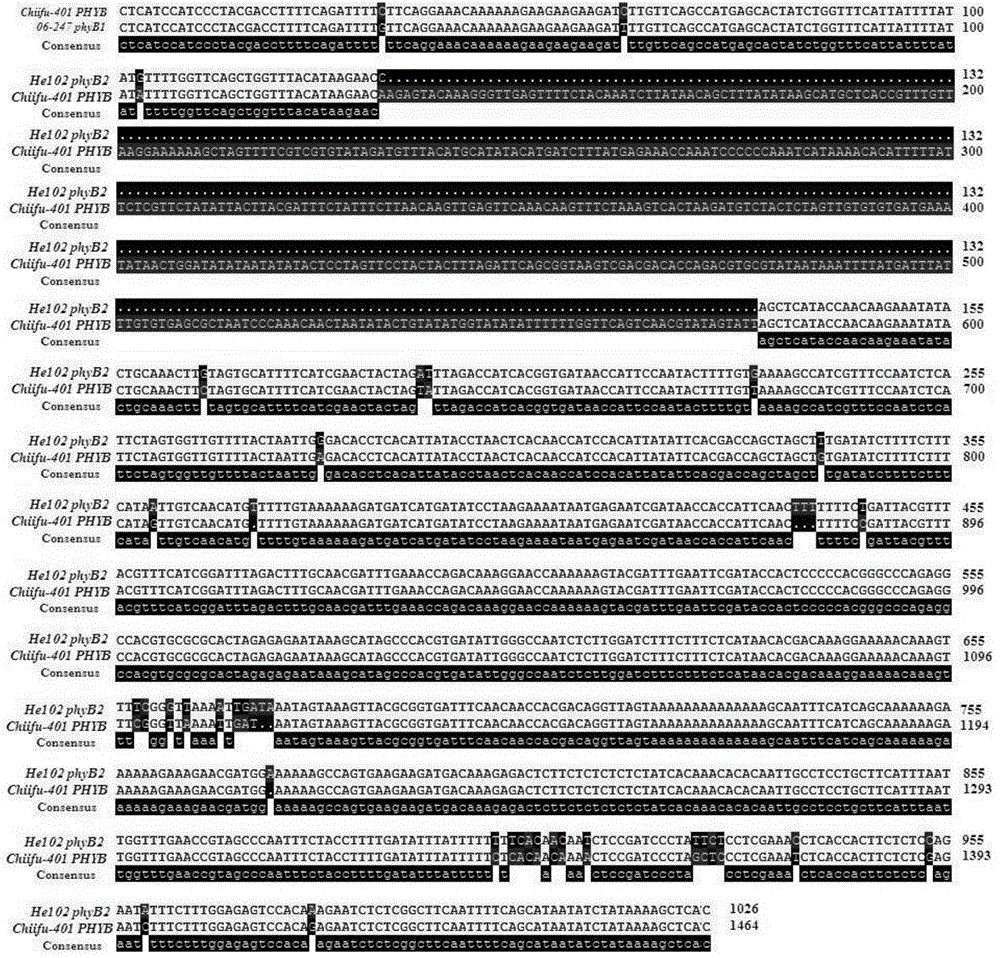Molecular marker closely linked with celery cabbage PHYB gene promoter allelic variation type phyB1/B2 and application of molecular marker
A technology of molecular markers and allelic variation, which is applied in the determination/testing of microorganisms, DNA/RNA fragments, recombinant DNA technology, etc., can solve problems such as differences in flowering time and large differences in bolting and flowering traits, and achieve accurate results and easy operation. Convenience and improvement of identification efficiency
- Summary
- Abstract
- Description
- Claims
- Application Information
AI Technical Summary
Problems solved by technology
Method used
Image
Examples
Embodiment 1
[0035] Embodiment 1, the cloning of PHYB gene promoter sequence in different Chinese cabbage inbred line materials
[0036] 1.1 Chinese cabbage genomic DNA extraction
[0037] (1) Put the leaves of Chinese cabbage seedlings into a liquid nitrogen pre-cooled mortar, and grind them into powder in liquid nitrogen;
[0038] (2) After the liquid nitrogen evaporates to dryness, transfer it to a 2ml centrifuge tube immediately, add about 0.6ml of CTAB extract preheated to 65°C for every 100mg of material, after melting, vigorously shake and mix the sample, place it in a 65°C water bath for 40- 60 minutes to lyse the cells;
[0039] (3) After the lysis is complete, take out the sample and let it cool down to room temperature completely. Add an equal volume of chloroform (chloroform), gently invert to mix, and place at room temperature for 10 minutes;
[0040] (4) Centrifuge at 12000 rpm for 15 minutes at room temperature;
[0041] (5) Use a pipette to carefully suck out the upper ...
Embodiment 2
[0061] Example 2 Development of co-dominant ASM markers
[0062] 2.1 Primer design
[0063] Carefully compare the genome sequences of the two allelic variants phyB1 and phyB2 of the PHYB gene. The main difference is a large deletion of 445 bp at the 5' end (such as image 3 shown). As the forward primer, the primer PF for amplifying the promoter was used, and a reverse primer PR1 was designed in the conserved region downstream (3' end) of the missing large fragment. The sequence Seq ID No.4 was commissioned to be synthesized by BGI.
[0064] 2.2 Acquisition of ASM mark
[0065] (1) Using the genomic DNA of He102 and 06-247 as templates, a PCR amplification was carried out with a common taq enzyme. Extend at 72°C for 40 seconds, 35-38 cycles, and finally extend at 72°C for 5 minutes.
[0066] (2) The amplified product was detected by electrophoresis on a 1.5% agarose gel, and photographed after EB staining. The results are as follows: Figure 5 shown. As can be seen from ...
Embodiment 3
[0067] Example 3 Detection of ASM markers on the F2 population constructed by He102×06-247.
[0068] (1) Genomic DNA extraction from different individual plants of the F2 population was as described in 1.1.
[0069] (2) PCR amplification: The preparation and amplification conditions of the PCR reaction solution are as described in Section 2.2 (1).
[0070] (3) Detection of PCR products is as described in Section 2.2 (2). Test results such as Image 6 Shown: P1 and P2 are the parents He102 and 06-247 respectively, 1-16 are 16 F2 individual plants. Individual plants 2, 3, 4, 7, and 15 in the figure are allelic variation types phyB2 in parent P1, namely He102, and individual plants 5, 9, 11, 12, 13, and 16 are allelic variation types in parent P2, namely 06-247 phyB1, the rest of the individual plants are heterozygous. M is the DNA molecular weight standard DL2000. From the amplification results, it can be seen that the pair of primers can identify homozygous wild type and h...
PUM
 Login to View More
Login to View More Abstract
Description
Claims
Application Information
 Login to View More
Login to View More - R&D
- Intellectual Property
- Life Sciences
- Materials
- Tech Scout
- Unparalleled Data Quality
- Higher Quality Content
- 60% Fewer Hallucinations
Browse by: Latest US Patents, China's latest patents, Technical Efficacy Thesaurus, Application Domain, Technology Topic, Popular Technical Reports.
© 2025 PatSnap. All rights reserved.Legal|Privacy policy|Modern Slavery Act Transparency Statement|Sitemap|About US| Contact US: help@patsnap.com



